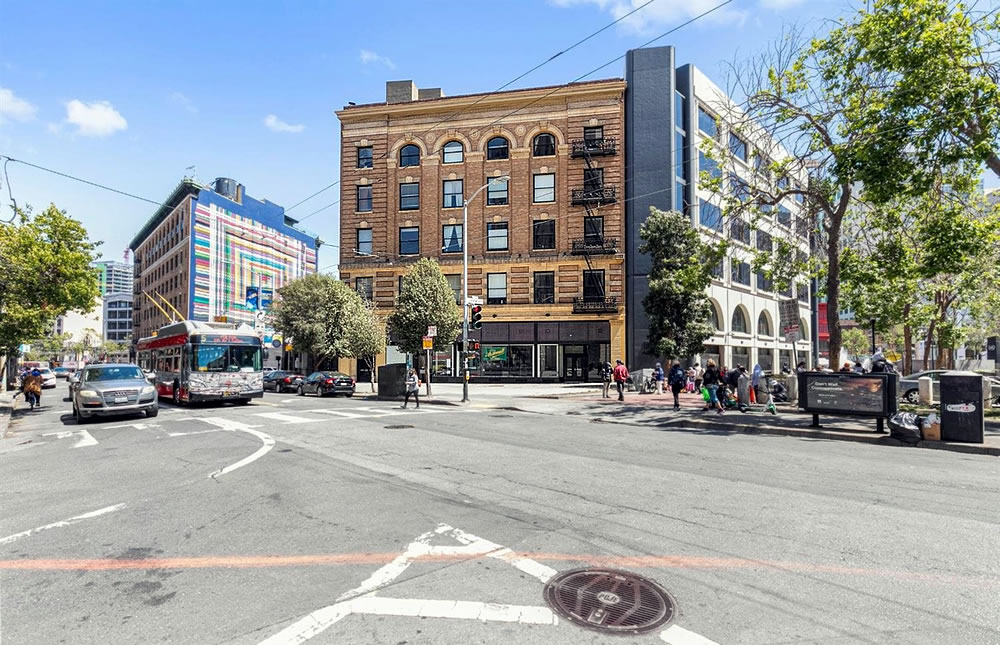Purchased for $288,000 in December of 2006, the 254-square-foot studio unit #405 in the Book Concern Building at 83 McAllister Street resold for $365,000 in July of 2021, representing net appreciation of 26.7 percent since the fourth quarter of 2006 on an apples-to-apples basis or roughly 1.6 percent per year, despite the unit having been “used” for nearly 15 years.
Returned to the market priced at $349,000 this past June, the list price for the “best price[d] market rate condo,” which offers “an ultra-efficient layout” along with “a central location [that] allows for easy access to public transportation, shops, restaurants and nightlife,” was reduced to $319,000 in August and then dropped to $299,000 in November.
And having just closed escrow with a contract price of $289,000, the resale of 83 McAllister Street #405 was officially “within 4 percent of asking!” and “over $1,000 per square foot!” according to all industry stats and marketing metrics but down 20.8 percent on an apples-to-apples basis from the third quarter of 2021 and within a percent of its value 17 years ago.




“within a percent of its value 17 years ago.”
Within a percent of its “price”, but not it’s “value”, because the value of the dollar changed.
Inflation adjusted, the $288K in 2006 would need a purchase price of $438,640 to have the same value. So this place lost 35% of its “value” since 2006.
The reasons are 1) a deflating zero-interest investing bubble that forced investors into risky startups and allowed large companies to try things at virtually no cost, so no idea was considered too far-fetched; 2) a work from home paradigm shift that no longer tethers nearby housing to well paying jobs; and 3) progressive policies of taxes and tolerance about which people cared less on the economic way up than the way down. The first is really just getting under way (Amazon just today announced significant layoffs, and less-well-publicized startups that were hanging on by their fingernails are falling by the wayside), the second seems to have been played out but doesn’t seem to be going away soon, and the third: stay tuned.
I object to this negativity. Why, according to a U-Haul report on January 2 (that for some reason has been almost totally ignored), California is still number one….in outbound migration!
Let’ go full circle on this: how does the cost of dropping off a U-Haul 17 years ago compare with picking one up today ??
The state with the highest population has highest U-haul transactions? Ground breaking! Next we will hear that there are more murders in Los Angeles than in Tyler, Texas.
It’s not “transactions;” it’s net loss, as a %, so undoubtedly #1 in absolute loss numbers as well. Thank you for allowing me to clarify. My bad for not expecting nitpicking. The editor here generally deletes external links, but the story is easily found using obvious keywords.
I, too, read the article.
“Since California’s population is much higher than most states, it can be expected that data gathered from raw numbers of truck rentals in the state would seem inordinately large compared with data from less-populated places. Data from within the state is a little more balanced: The numbers of departures and arrivals of one-way U-Haul renters were almost equal, with 50.8% of California’s one-way truck rentals being departures and 49.2% being arrivals.”
So, at least by U-Haul stats, those who are leaving are being replaced at about the same rate.
The quality of life for that block is quiet low, with the plaza out front used for open market drug dealing and camping. When I looked at the building in 2015, there was a cafe and bakery with chairs in that spot out front which would have been a big selling point or urban living. The pricing likely reflects the poor curb appeal as any clients viewing the unit will need to cross the plaza.
Any buyer in that building is betting on a upswing in that area, which might not be a bad plan.
With studio units like these and the UC law school nearby, maybe the building should be converted to student housing.
Perhaps you’re being distracted by the nominal amounts involved here. With the average asking price per square foot of the homes in contract across the city under $900 in the fourth quarter of 2023, and the buyer of studio unit 405 just having paid about $1,138 per ², these units are commanding a premium for the privilege of allowing people with comparatively little savings for a home purchase onto the property ladder.
As far as the UC law school, they already have dedicated student housing at the recently completed and opened 656-unit complex, The Academe at 198 McAllister St.
You’re going to compare the PSF of a *checks notes* studio to other homes that are no doubtedly larger?
It’s a studio. Of course it’s going to have a high PSF.
And don’t expect Golden Gate Law School (with their cool campus on Mission Street – see name link) to pick up the slack. The law school portion of that University is shutting down in May.
I always thought that building was a BMR project. In which case, it’s they City who sets the price.
While the Book Concern Building certainly offers some below market rate units (such as the apartment nearest to the above-featured one, Apt 404, currently asking $196k for qualified buyers), the building as a whole features a mix of affordable and market-rate units.
In a post-pandemic world there aren’t a lot of cities where living in a 254sqft box with no outdoor access remains attractive, and I’d argue that SF is not one of those cities.
Perhaps not attractive to some of us here but it might work for someone with neither a lot of money nor a lot of stuff.
The location is problematic and it will likely take many years for that to change. That said, its also at the lower end of the price range.